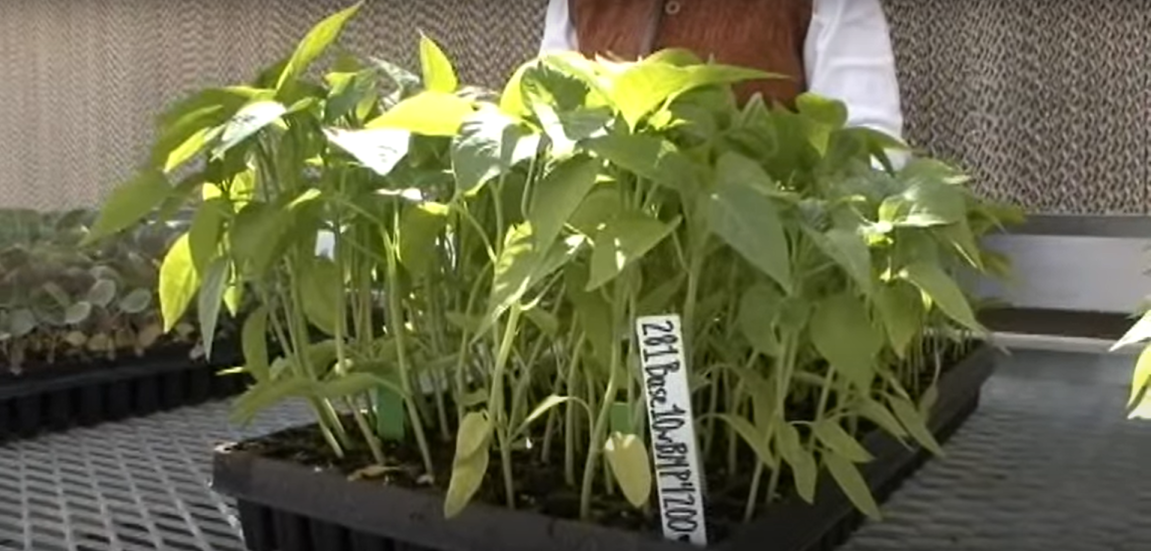The brief 9-minute film “Vermicompost: A Living Soil Amendment” by Cornell University gives a comprehensive overview of vermicomposting (worm composting), highlighting its role as a transformative technology for converting organic waste into valuable resources. It looks at using vermicompost for managing plant nutrients and combating plant diseases.
Pay particular attention at the 2:50 min mark where you’ll see the dramatic difference between growing peppers in different mediums.
Medium One (control):
This is the “control medium”. It is a base growing mix consisting of vermiculite, perlite, peat moss, and dolomitic lime. The result is what would be considered a normal growth rate of pepper plants.
Medium Two (added vermicompost):
Consists of the same base mix with 10% added vermicompost. Notice the pepper plants are almost double in size compared to the control medium.
Medium Three (added vermicompost +):
Is the same as medium two, with the addition of green sand, rock phosphate, and blood meal. Notice the pepper plants are almost 3 times the size compared to the control. Check out the video below…
Discover how to produce more organic worm compost faster than ever before with our original step by step guide to worm composting.
Vermicompost as a Living Soil Amendment: Key Points
What Makes Vermicompost So Powerful?
Vermicompost isn’t just compost, it’s alive. It’s full of microbes and tiny critters that help protect plants and improve soil health. When you use it around your seedlings, it actually helps defend them from disease. That’s thanks to all the beneficial bacteria, fungi, and other organisms that break down organic matter underground.
Composting are the stars of the show. As they eat through organic material, they digest it and leave behind castings—nutrient-rich waste that helps feed plants. In a way, worms are like little farmers raising helpful microbes inside their guts.
The Worm Life Cycle (It’s Pretty Cool)
Worms are hermaphrodites, which means they have both male and female parts. When two worms mate, they form a slimy band that eventually turns into a cocoon. A few weeks later, baby worms hatch and keep the cycle going. This constant reproduction keeps your worm bin full and productive.
There’s More Than Just Worms in the Mix
A healthy vermicompost system also includes tiny creatures like mites, springtails, and pseudoscorpions. These little guys feed on microbes and help maintain balance in the compost ecosystem. Think of it as a mini jungle underground, all working together to keep your soil thriving.
Why Greenhouses Are Turning to Vermicompost
In commercial greenhouses, growers often rely on synthetic nutrients. But more and more, they’re looking at vermicompost as a renewable alternative. It provides real, slow-release nutrients and helps reduce the need for chemicals.
This experiment looked at pepper plants grown in different soil mixes. The mix that included vermicompost, greensand, rock phosphate, and blood meal outperformed the standard potting mix. Plants grew better and stayed healthier.
Temperature Matters
Since vermicompost is alive, it works best when temperatures are just right. Microbes need warmth to stay active and break down nutrients. In greenhouses, keeping things in the right range means better nutrient release and healthier plants.
Fighting Off Plant Diseases Naturally
One big benefit? Vermicompost helps fight off soil diseases. For example, it’s been shown to reduce the effects of Pythium aphanidermatum, a nasty fungus that harms young seedlings. The living microbes seem to disrupt the pathogen’s ability to attack roots. Interestingly, sterilized vermicompost doesn’t work the same way, so it’s clear that live microbes are the key.
Good for Your Garden, Good for the Planet
Vermicomposting is a great way to turn kitchen scraps and organic waste into something useful. Back in 2008, the EPA said around 38% of landfill waste could’ve been composted. That’s a huge missed opportunity. Vermicomposting helps cut down on that waste while reducing pollution in soil, water, and air.
You Can Start Small – Even in an Apartment
Don’t have a yard? No problem. Vermicomposting works indoors too. All you need is a bin, some worms, and a steady supply of food scraps and shredded paper. It’s a great way to cut down on trash and make your own fertilizer at home.
Worms Mean Business (Literally)
Some folks take it a step further and turn vermicomposting into a small business. You’ll find entrepreneurs selling worm bins, compost, and worms themselves at farmers markets or online. It’s a nice way to make extra income and help others garden more sustainably.
On the Big Scale: Farms and Commercial Ops
Large-scale worm farms take things up a notch. They process tons of organic waste, like cow manure, and turn it into rich compost. Usually, the manure is briefly hot-composted first to kill off bad stuff like weed seeds and pathogens. Then the worms finish the job.
This process is a win-win for farmers. It gives them a valuable soil amendment and helps manage manure without polluting nearby water sources. Cleaner farms, healthier soil.
Final Thoughts
Vermicomposting is one of those rare things that’s good for your garden and the environment. Whether you’re working with a tiny bin under your kitchen sink or running a full-scale farm, it turns waste into something valuable. You get healthier plants, less disease, and a smaller footprint on the planet. That’s a win all around.



